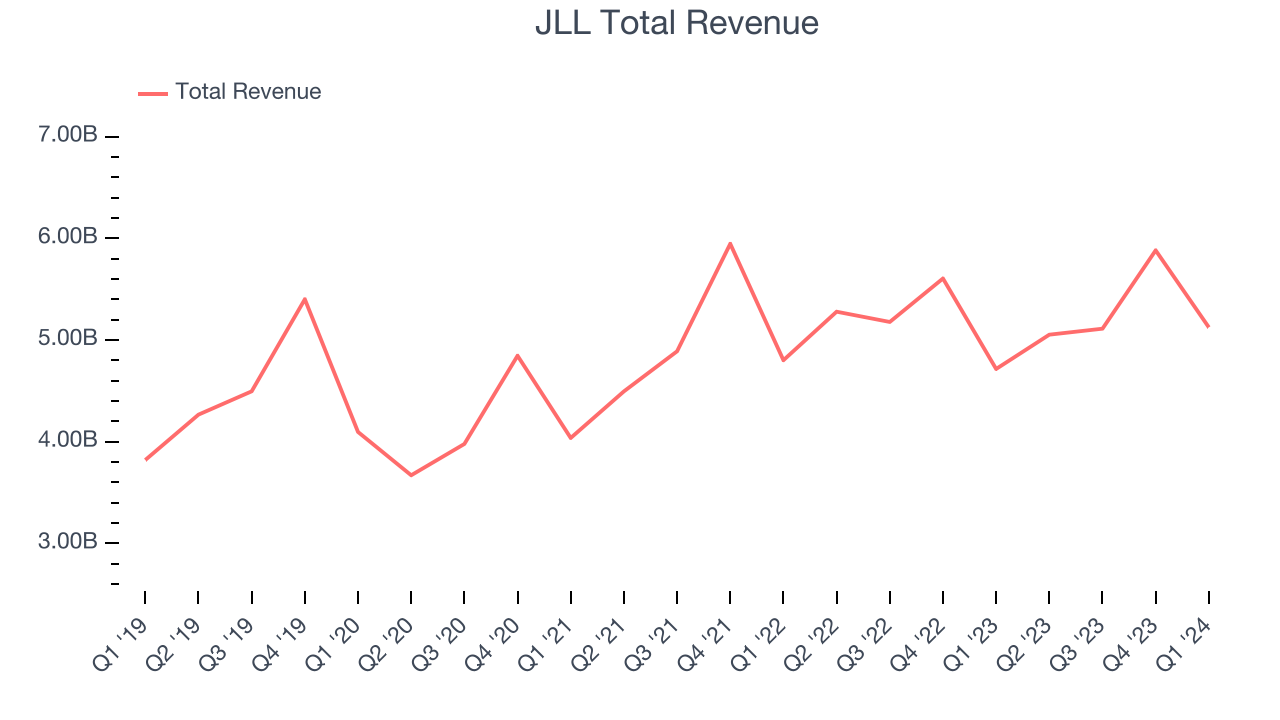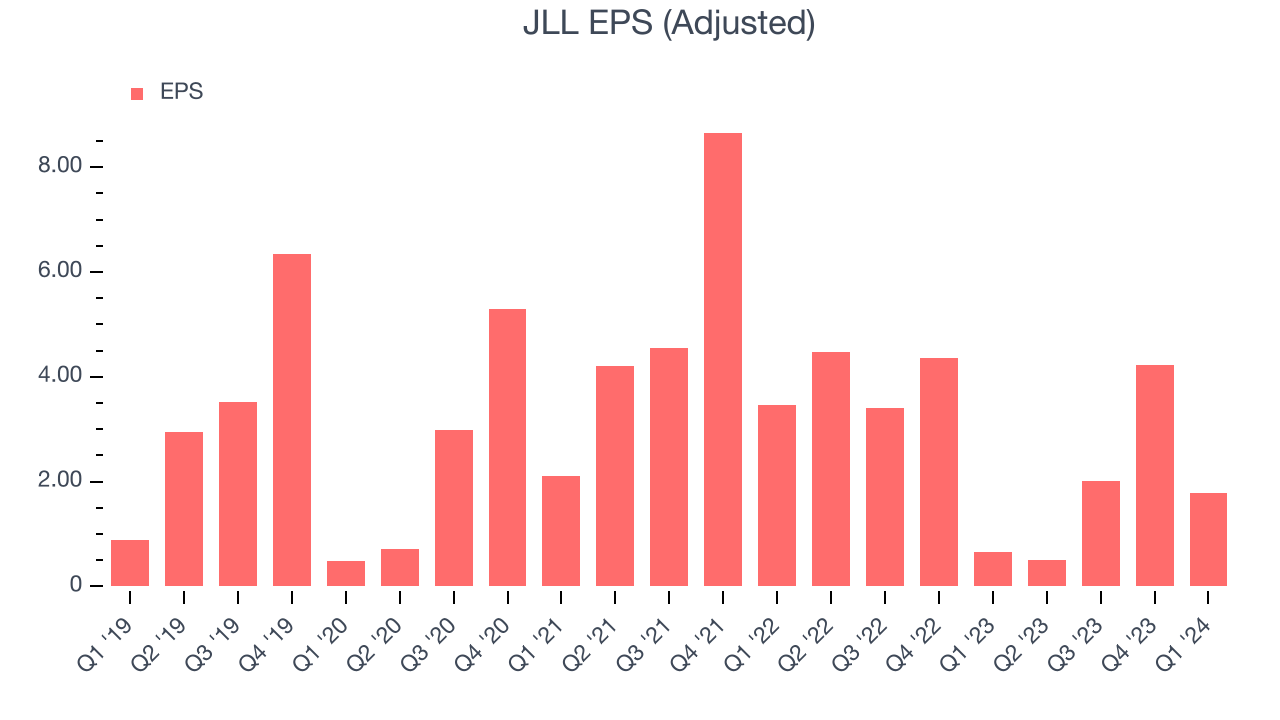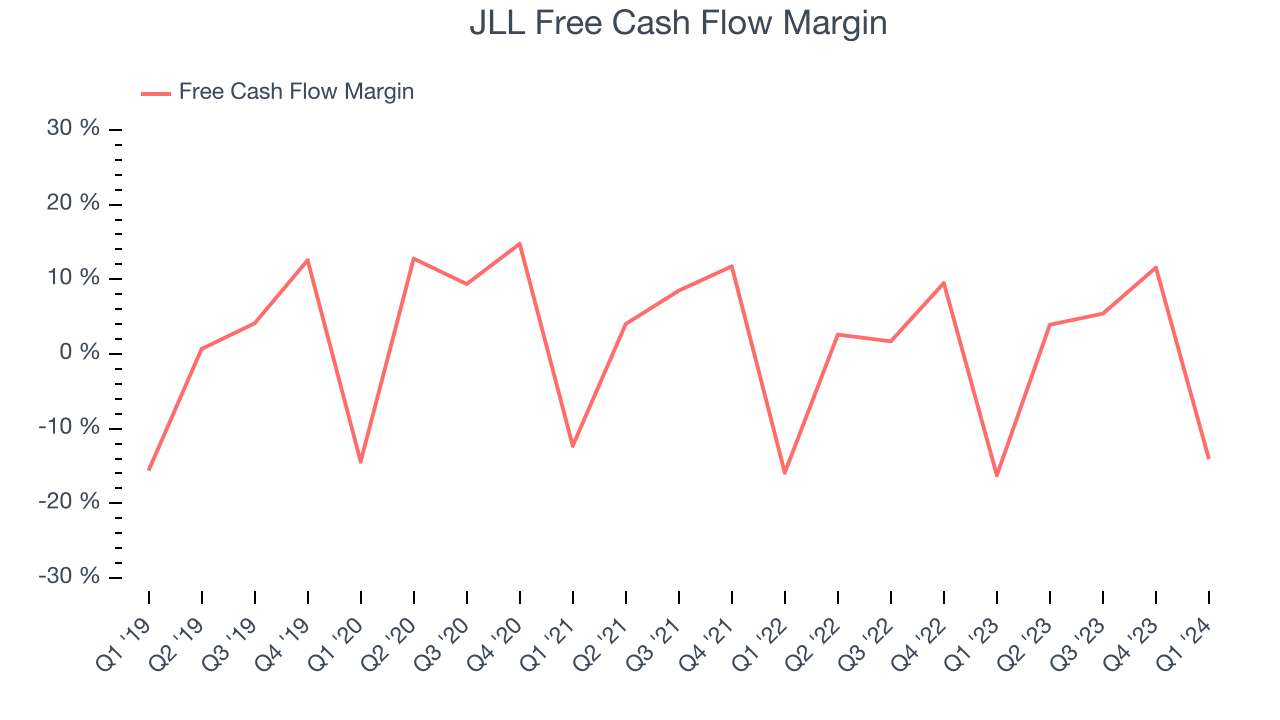Real estate firm JLL (NYSE:JLL) reported Q1 CY2024 results topping analysts' expectations, with revenue up 8.7% year on year to $5.12 billion. It made a non-GAAP profit of $1.78 per share, improving from its profit of $0.65 per share in the same quarter last year.
JLL (JLL) Q1 CY2024 Highlights:
- Revenue: $5.12 billion vs analyst estimates of $4.82 billion (6.4% beat)
- EPS (non-GAAP): $1.78 vs analyst estimates of $0.86 (106% beat)
- Gross Margin (GAAP): 50.6%, in line with the same quarter last year
- Free Cash Flow was -$720.7 million, down from $680.2 million in the previous quarter
- Market Capitalization: $8.81 billion
Founded in 1999 through the merger of Jones Lang Wootton and LaSalle Partners, JLL (NYSE:JLL) is a company specializing in real estate advisory and investment management services.
JLL’s extensive service portfolio encompasses agency leasing, capital markets, property management, facility management, project and development services, tenant representation, real estate investment management, valuation, and advisory services. This comprehensive range of offerings allows JLL to cater to a diverse array of client needs, from individual property owners and corporate occupiers to large institutional investors.
The company operates across various real estate sectors, including office, retail, industrial, multi-family residential, hotels, and healthcare facilities. JLL's approach combines deep industry knowledge with technology-driven solutions, enabling it to provide insightful, data-driven advice and services to its clients.
JLL's investment management arm, LaSalle Investment Management, is a significant component of its business, managing assets for a wide range of investors, including public and private pension funds, insurance companies, governments, endowments, and private individuals. LaSalle Investment Management is known for its global investment approach, allowing it to identify and capitalize on investment opportunities in different regions and real estate subsectors.
Real Estate Services
Technology has been a double-edged sword in real estate services. On the one hand, internet listings are effective at disseminating information far and wide, casting a wide net for buyers and sellers to increase the chances of transactions. On the other hand, digitization in the real estate market could potentially disintermediate key players like agents who use information asymmetries to their advantage.
JLL’s primary competitors include CBRE (NYSE:CBRE), Cushman & Wakefield (NYSE:CWK), Colliers International (NASDAQ:CIGI), and Savills (LSE:SVS).Sales Growth
Reviewing a company's long-term performance can reveal insights into its business quality. Any business can have short-term success, but a top-tier one sustains growth for years. JLL's annualized revenue growth rate of 5% over the last five years was weak for a consumer discretionary business.  Within consumer discretionary, a long-term historical view may miss a company riding a successful new product or emerging trend. That's why we also follow short-term performance. JLL's recent history shows the business has slowed as its annualized revenue growth of 2.5% over the last two years is below its five-year trend.
Within consumer discretionary, a long-term historical view may miss a company riding a successful new product or emerging trend. That's why we also follow short-term performance. JLL's recent history shows the business has slowed as its annualized revenue growth of 2.5% over the last two years is below its five-year trend.
We can better understand the company's revenue dynamics by analyzing its three most important segments: Work Dynamics, Markets Advisory, and Capital Markets, which are 71%, 18.5%, and 7.4% of revenue. Over the last two years, JLL's Work Dynamics revenue (operational workflows) averaged 9% year-on-year growth while its Markets Advisory (real estate insights) and Capital Markets (financial transactions) revenues averaged declines of 1.9% and 16.8%.
This quarter, JLL reported solid year-on-year revenue growth of 8.7%, and its $5.12 billion of revenue outperformed Wall Street's estimates by 6.4%. Looking ahead, Wall Street expects sales to grow 5.9% over the next 12 months, a deceleration from this quarter.
Operating Margin
Operating margin is an important measure of profitability. It’s the portion of revenue left after accounting for all core expenses–everything from the cost of goods sold to advertising and wages. Operating margin is also useful for comparing profitability across companies with different levels of debt and tax rates because it excludes interest and taxes.
JLL was profitable over the last two years but held back by its large expense base. Its average operating margin of 3.3% has been paltry for a consumer discretionary business.
This quarter, JLL generated an operating profit margin of 2.2%, up 1.9 percentage points year on year.
EPS
We track long-term historical earnings per share (EPS) growth for the same reason as long-term revenue growth. Compared to revenue, however, EPS highlights whether a company's growth was profitable. 
Over the last five years, JLL's EPS dropped 39.3%, translating into 6.9% annualized declines. We tend to steer our readers away from companies with falling EPS, where diminishing earnings could imply changing secular trends or consumer preferences. Consumer discretionary companies are particularly exposed to this, leaving a low margin of safety around the company (making the stock susceptible to large downward swings).
In Q1, JLL reported EPS at $1.78, up from $0.65 in the same quarter last year. This print easily cleared analysts' estimates, and shareholders should be content with the results. Over the next 12 months, Wall Street expects JLL to grow its earnings. Analysts are projecting its LTM EPS of $8.53 to climb by 48.1% to $12.63.
Cash Is King
If you've followed StockStory for a while, you know we emphasize free cash flow. Why, you ask? We believe that in the end, cash is king, and you can't use accounting profits to pay the bills.
Over the last two years, JLL has shown mediocre cash profitability, putting it in a pinch as it gives the company limited opportunities to reinvest, pay down debt, or return capital to shareholders. Its free cash flow margin has averaged 1%, subpar for a consumer discretionary business.

JLL burned through $720.7 million of cash in Q1, equivalent to a negative 14.1% margin, increasing its cash burn by 5.9% year on year.
Return on Invested Capital (ROIC)
EPS and free cash flow tell us whether a company was profitable while growing revenue. But was it capital-efficient? A company’s ROIC explains this by showing how much operating profit a company makes compared to how much money the business raised (debt and equity).
JLL's five-year average return on invested capital was 7.9%, somewhat low compared to the best consumer discretionary companies that pump out 25%+. Its returns suggest it historically did a subpar job investing in profitable business initiatives.

The trend in its ROIC, however, is often what surprises the market and drives the stock price. Unfortunately, JLL's ROIC has stayed the same over the last few years. If the company wants to become an investable business, it will need to increase its returns.
Balance Sheet Risk
Debt is a tool that can boost company returns but presents risks if used irresponsibly.
JLL reported $396.7 million of cash and $1.81 billion of debt on its balance sheet in the most recent quarter. As investors in high-quality companies, we primarily focus on two things: 1) that a company's debt level isn't too high and 2) that its interest payments are not excessively burdening the business.
With $814.8 million of EBITDA over the last 12 months, we view JLL's 1.7x net-debt-to-EBITDA ratio as safe. We also see its $78.6 million of annual interest expenses as appropriate. The company's profits give it plenty of breathing room, allowing it to continue investing in new initiatives.
Key Takeaways from JLL's Q1 Results
We were impressed by how significantly JLL blew past analysts' EPS expectations this quarter. We were also excited its operating margin outperformed Wall Street's estimates. Zooming out, we think this was a solid quarter. The stock is up 2.8% after reporting and currently trades at $190.5 per share.
Is Now The Time?
JLL may have had a good quarter, but investors should also consider its valuation and business qualities when assessing the investment opportunity.
We cheer for all companies serving consumers, but in the case of JLL, we'll be cheering from the sidelines. Its revenue growth has been uninspiring over the last five years, but at least growth is expected to increase in the short term. And while its projected EPS for the next year implies the company's fundamentals will improve, the downside is its declining EPS over the last five years makes it hard to trust. On top of that, its low free cash flow margins give it little breathing room.
JLL's price-to-earnings ratio based on the next 12 months is 14.7x. While we've no doubt one can find things to like about JLL, we think there are better opportunities elsewhere in the market. We don't see many reasons to get involved at the moment.
Wall Street analysts covering the company had a one-year price target of $218.86 per share right before these results (compared to the current share price of $190.50).
To get the best start with StockStory, check out our most recent stock picks, and then sign up for our earnings alerts by adding companies to your watchlist here. We typically have the quarterly earnings results analyzed within seconds of the data being released, and especially for companies reporting pre-market, this often gives investors the chance to react to the results before the market has fully absorbed the information.
